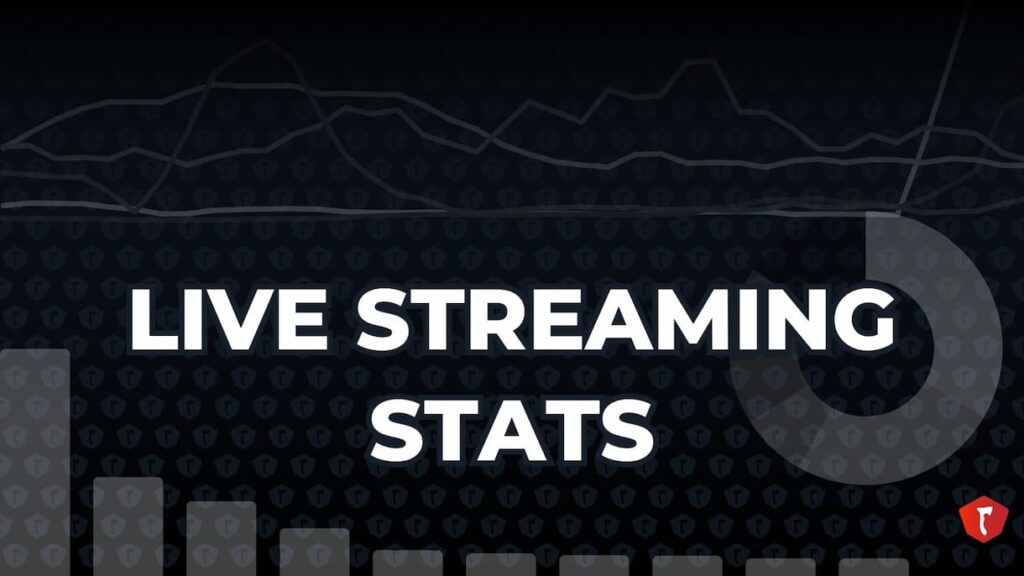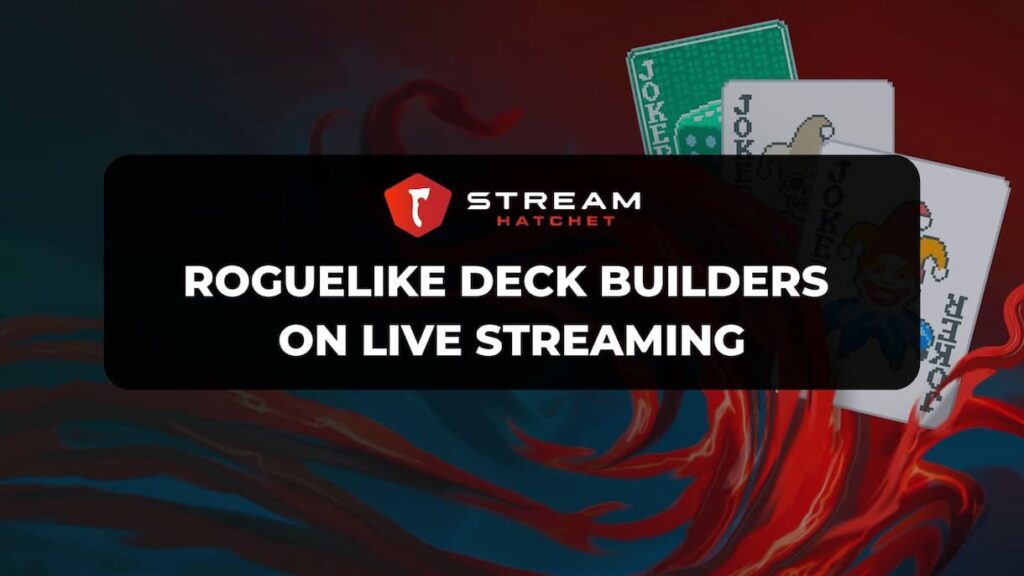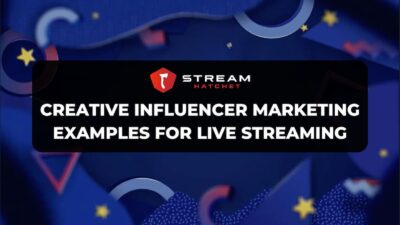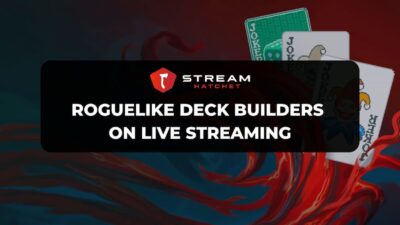With so many databases available online like SteamDB, finding data is no longer the primary issue for brands or publishers looking to measure the success of their latest product launch. Rather, the difficulty comes with finding useful data amidst so much noise. Sifting through stream stats can feel overwhelming, leaving one unsure of the data’s validity and its usefulness in analyzing a campaign’s success.
In this article, we’re going through these various streaming stats to see how each one can be best interpreted by brands or publishers looking to engage with the live-streaming space. The accompanying graphs are past examples of how these metrics might be visualized.
The stream stats discussed below come from five key areas:
When it comes to data quality, Stream Hatchet is the leading live-streaming data platform on the market. Stream Hatchet accumulates data from every major live-streaming platform with the industry’s highest standard of 1-minute granularity to ensure the highest accuracy possible. For an example of our up-to-date data pulls, check out our rankings pages:
Viewership Stats: Hours Watched, AMA, and Peak Viewership
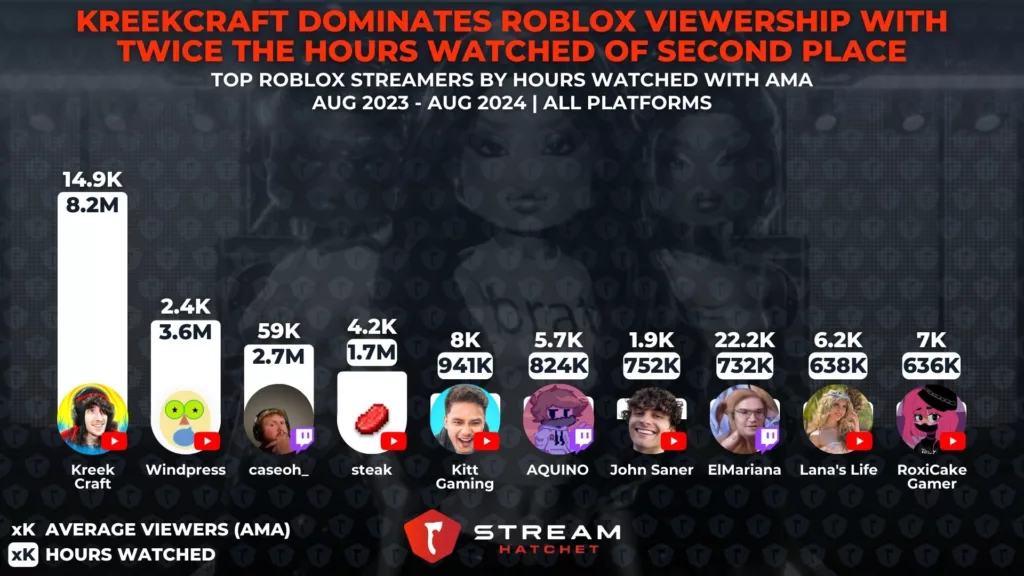
Hours Watched: The total time viewers spent watching a stream / many streams combined.
Purpose: Indicates overall audience interest and engagement with the content, helping brands gauge the effectiveness of the stream and its potential reach. The Hours Watched value can be misleading by itself, however, as it doesn’t tell the reader whether the number comes from a large number of people watching or from high retention among a relatively smaller audience.
Example: Gauging the popularity of subathon streams on Twitch by hours watched.
AMA (Average Minute Audience): The average number of viewers per minute over the specified time period.
Purpose: Useful for understanding the consistency of viewership, which helps brands assess audience retention. When taken together with Hours Watched, AMA can help determine whether a stream just saw an initial spike in viewership, or whether the stream was consistently entertaining.
Example: Determining the popularity of various Roblox streamers to distinguish between popular, low airtime streamers and less popular, high airtime streamers. This can help to determine which streamers are actually committed to Roblox content (and therefore more valuable long-term prospects for brand partnerships).
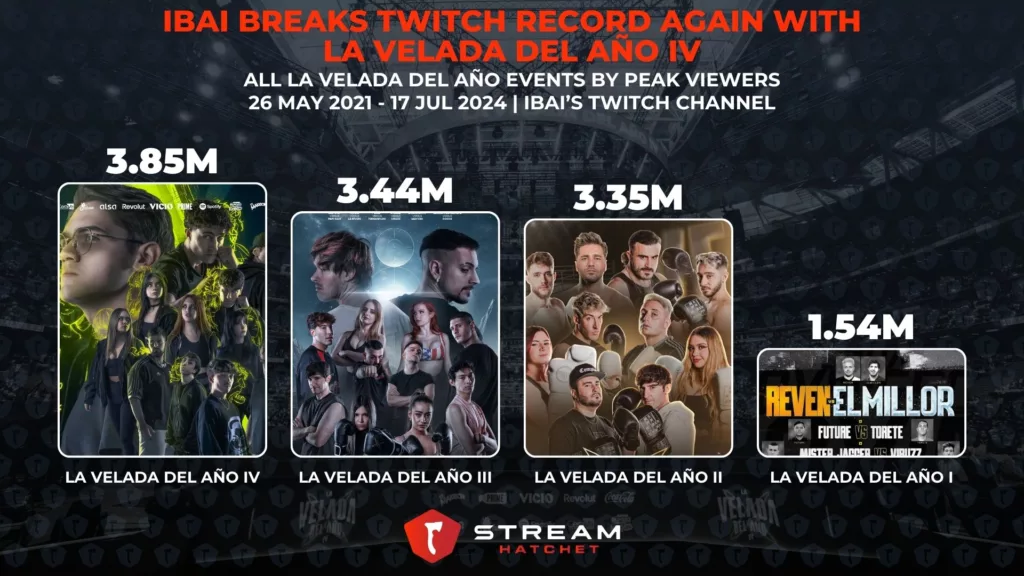
Peak Viewership: The highest number of concurrent viewers at any point during a given stream.
Purpose: Highlights the stream’s potential to attract attention and can help identify moments of peak interest. This can be particularly powerful for events, when brands are mostly interested in the maximum number of eyes on their product placement.
Example: Peak viewership can compare the relative popularity of an event over time, like Ibai’s La Velada del Año events – particularly useful for event organizers and sponsors.
Aggregated Peak Viewership: The combined peak concurrent viewers across multiple platforms or streams.
Purpose: Gives a broader view of audience size – useful for multi-platform campaigns and cross-channel engagement.
Example: Gauging the debut week performances of multiple games of a similar genre with an aggregated value accounts for slight variations in platform release times or regional distribution of players, such as the release of Silent Hill 2 Remake.
Coverage Stats: Airtime and Channels
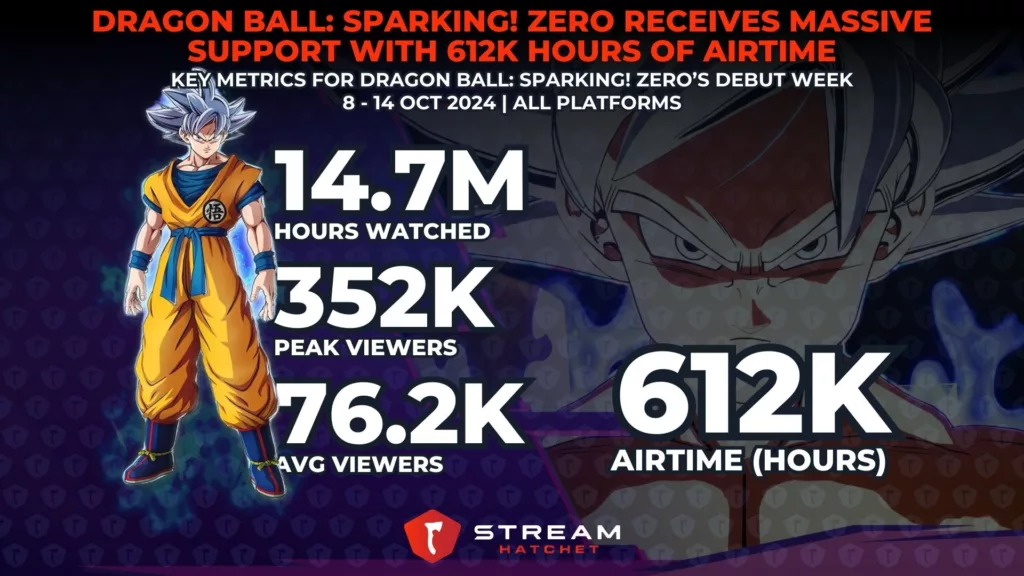
Airtime: Total duration of a stream / many streams combined.
Purpose: Longer airtime provides more opportunities for brand exposure and interaction, but this has to be balanced with viewer engagement metrics to tell if people are actually tuning in. As touched on earlier, higher airtime can also signal a streamer’s commitment to a particular game or event.
Example: The high airtime for Dragon Ball: Sparking! Zero indicates just how many streamers tried out the game for long stretches of time, rather than a surge of demand caused by a select few popular streamers.
Channel Count and Average Concurrent Channels: The number of different channels that broadcasted a particular game or event, either separately or at the same time.
Purpose: A larger number of channels can amplify reach and indicate the level of community engagement, whereas a higher average concurrent channel stat indicates more focus on a particular event (such as the launch of a new title).
Example: Fortnite not only features a massive viewership, but also support from the largest number of unique channels on Twitch – even more than Just Chatting streams (as of October 2023).
Fanbase Stats: Followers, Subscribers, and Audience Overlap
URVs (Unique Registered Viewers): The count of distinct viewers who watched a given stream / many combined streams.
Purpose: The most direct stream stat for understanding the size of the audience and measuring the potential reach of a brand’s message. This is particularly important for ensuring you aren’t double counting viewers who are interested in a particular topic.
Example: When gauging the popularity of a particular streamer like VTuber Dokibird, one can’t just add up the viewership from all her streams without double counting certain users. A URV count avoids this issue and gives a more accurate number of unique viewers tuning in.
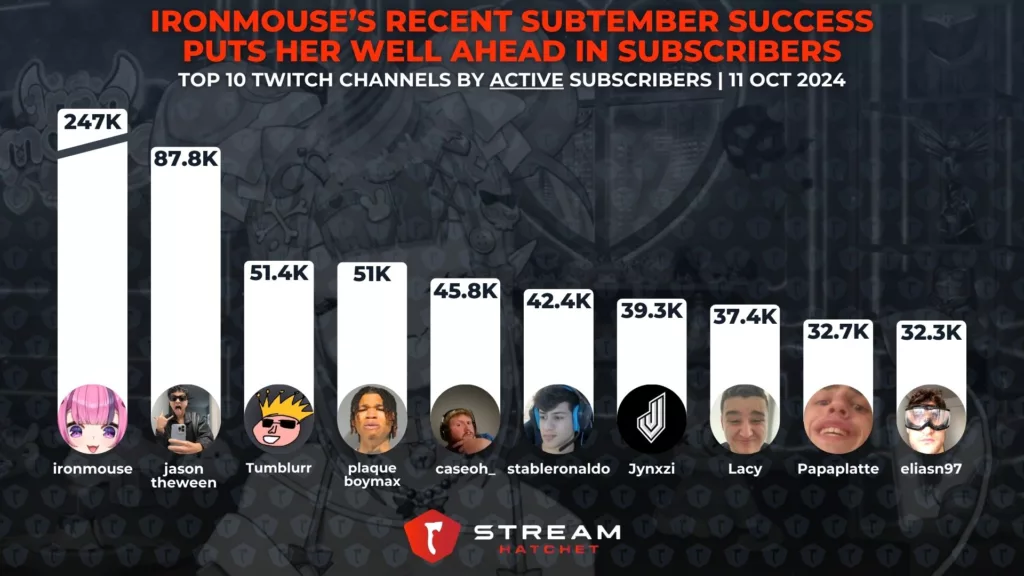
Followers: Users who opt to receive notifications for upcoming streams and other event announcements from a particular channel.
Purpose: Being a follower tends to indicate loyalty and interest, and so knowing a channel’s follower count helps brands identify influencers and communities for potential partnerships. In the world of live streaming, this is particularly important for Twitch streamers – but platforms like Instagram and TikTok also use this feature. The equivalent streamer stats on YouTube are called “subscribers” (not to be confused with the definition of subscribers below).
Example: Followers tend to accumulate over time, leading to the most followed Twitch streamers of all time being older creators like Ninja and Ibai.
Subscribers (Subs): Users that pay to follow a channel in exchange for exclusive perks on Twitch.
Purpose: Monetized followers show more dedicated support, offering brands insight into a creator’s influence and potential for sponsorship. On Twitch, the ability to attract subscribers is limited to streamers who have already found some small, consistent success. Kick stream stats work in a similar way, with non-paying vs. paying users as a measure of engagement.
Example: Plaqueboymax’s Twitch stream stats jumped significantly after his participation in SUBtember, mainly due to a rise in his subscriber count.
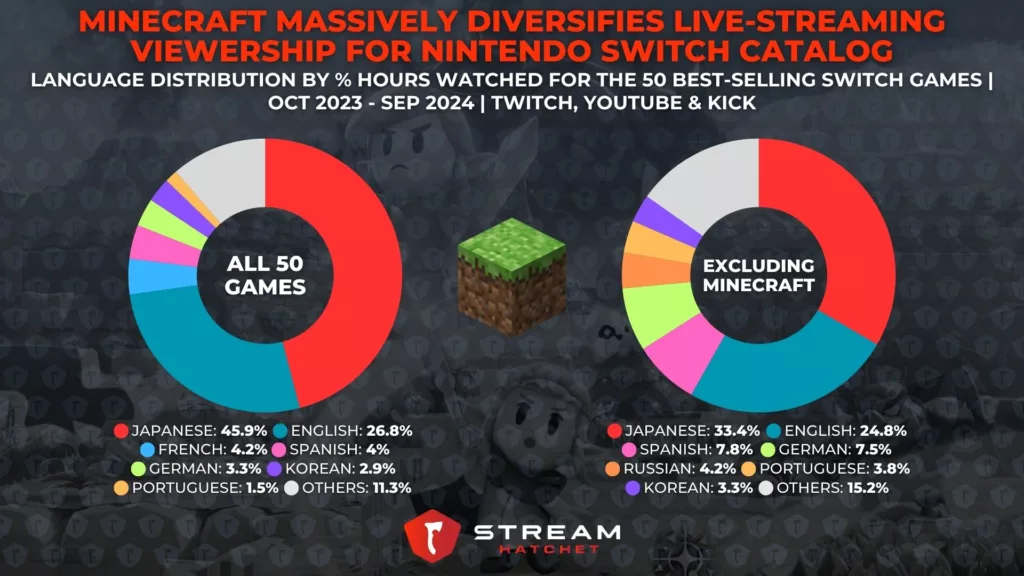
Language Distribution: The spread of viewers by language spoken, either by percent or raw count.
Purpose: Given that most viewers aren’t geo-tagged, language distribution is the best way of approximating their region. Languages also form a natural division among demographics that can influence a brand’s ability to reach these viewers.
Example: Nintendo has a primarily Japanese-speaking audience for their games on live streaming, making Nintendo Switch game streamers better partners for Japanese brands.
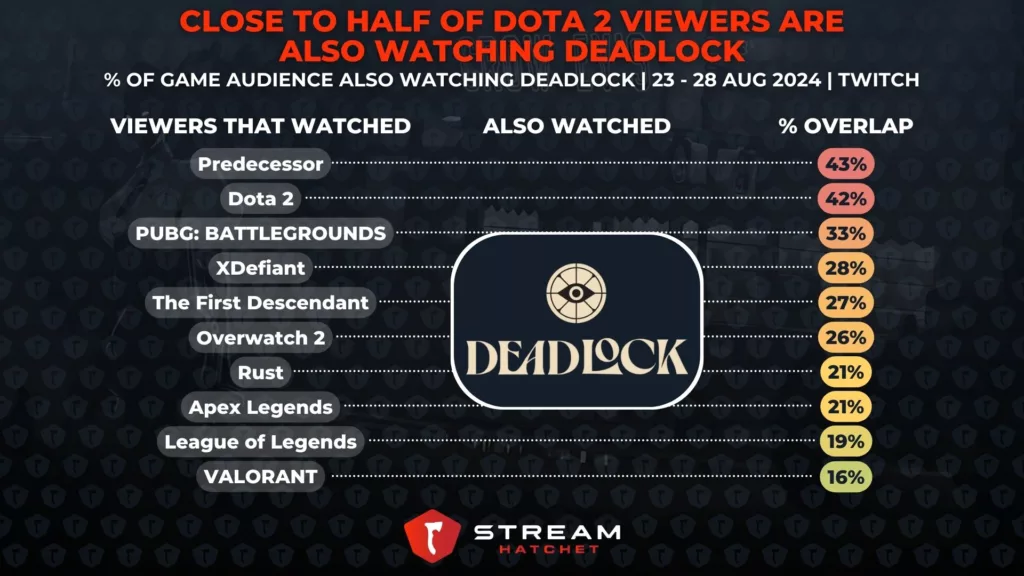
Audience Overlap: Percentage of viewers shared between two or more channels/games.
Purpose: Helps brands and publishers to identify cross-promotional opportunities and optimize content targeting strategies. Alternatively, publishers might use overlap data to see which games are competing for viewers on live streaming.
Example: Deadlock had a significant overlap with hero shooters and other shooter titles, yet less overlap with MOBA titles (despite being a blend of the two genres). This suggests its main competition may be other shooter titles upon its full release.
Cost-Benefit Stats: Logo Presence, Earned Media Value, and CPM
Logo Presence Share: Proportion of airtime where a brand’s logo is visible.
Purpose: A measure of brand visibility that allows brands to calculate the effectiveness of sponsorships and logo placements. Logo presence share also acts as a way to verify that event planners are holding up their end of the bargain when it comes to contractually obligated logo visibility.
Example: Payment service companies might be interested to know how much their logos feature across the full range of streams on Twitch – in 2022, VISA and Coinbase were the most visible payment service brands for viewers.
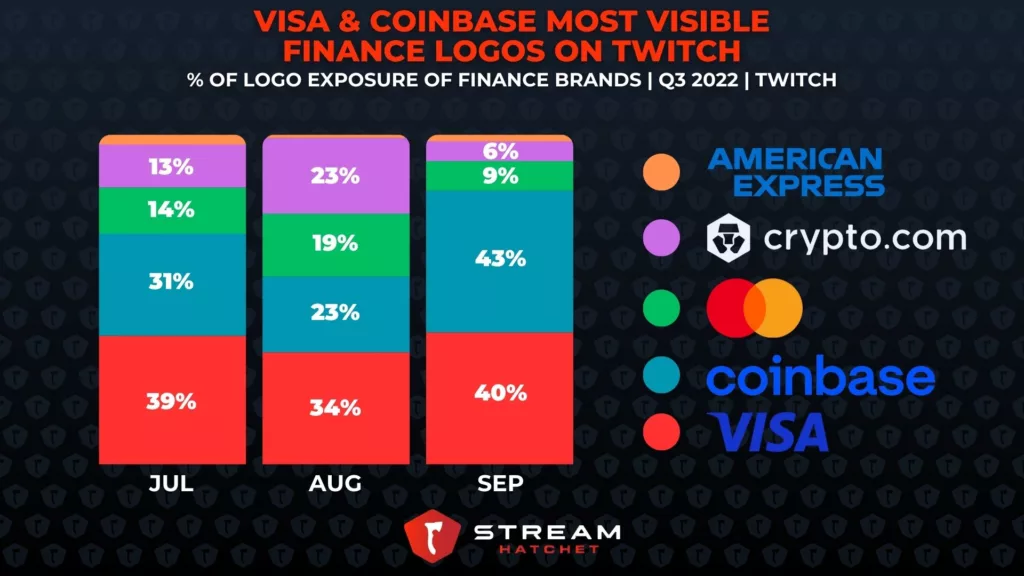
EMV (Earned Media Value): Estimated monetary value of media exposure gained through streams.
Purpose: Helps brands quantify the value of exposure compared to paid media, providing ROI insights for campaigns. 3rd party exposure can be far more difficult to track than paid media, so EMV gives campaigns an idea of how well these less controlled channels are contributing to their influencer marketing stats.
Example: A brand might take a holistic view of various customer reviews and 3rd party social media posts to see what their total EMV is, then decide whether to double down on these strategies by moving to a paid strategy with a successful creator.
CPM (Cost per Mille): The marketing cost per thousand views or impressions.
Purpose: Common for budgeting in advertising, CPM helps brands calculate the efficiency of their ad spend on live streams.
Example: In the opposite case to EMV, a brand might realize that their investment in a particular partner sponsorship is costing too much for how little return they are getting and decide to terminate the partnership.
Chat Analysis Stats: Chat Engagement, Mentions, and Sentiment
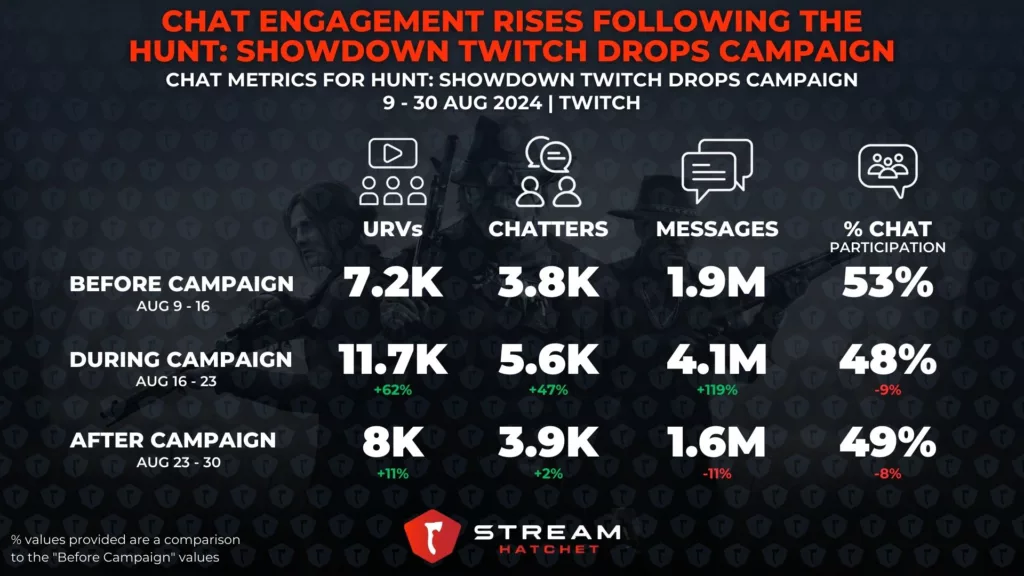
Chatter Count: The total number of unique users who participated in chat.
Purpose: Indicates active viewer engagement, showing how interactive the stream was. Consistent chatter counts over many streams show that the streamer has fostered a vocal community.
Chat Messages: Total number of messages sent during the stream.
Purpose: More chat messages indicate high viewer interaction, helping gauge audience engagement. More chat messages might also indicate a controversial or hyped moment, where people spammed the chat with one-word messages and emotes.
Chat Engagement: Rate of interaction through chat per viewer.
Purpose: A high engagement rate signals a responsive and active audience, which is valuable for marketing efforts that require viewer participation. This stream stat looks at the proportion of URVs that are also chatters.
Example of Chatter Count, Chat Messages, and Chat Engagement: During Twitch Drops campaigns (like the one for Hunt: Showdown), plenty of viewers could passively tune into a stream to collect their in-game loot. But for advertisers, it’s more useful to know whether these viewers are actually engaging with the streamer. Chat Engagement and Chat Messages are a fantastic, quick way to gauge this engagement.
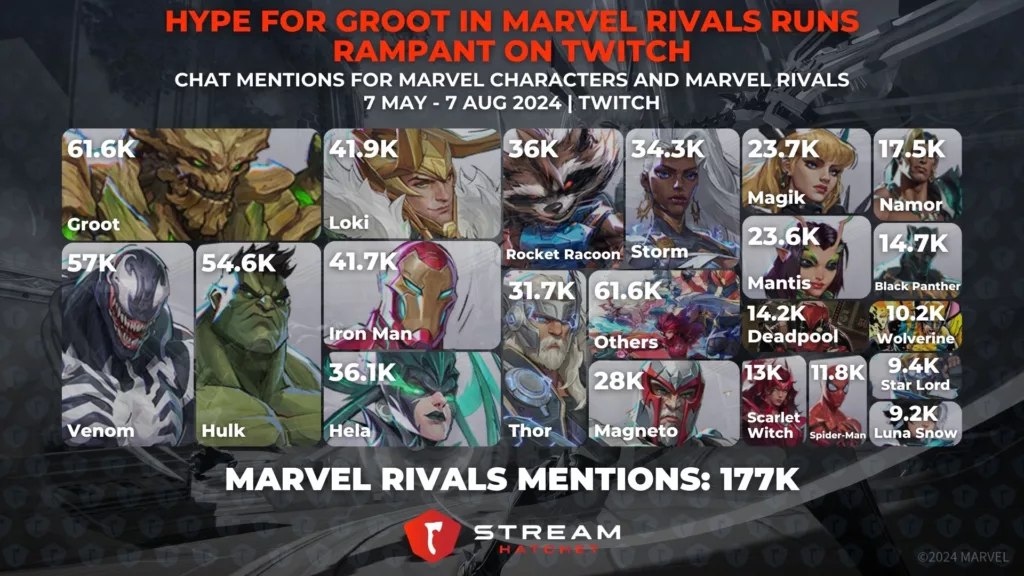
Chat Mentions: The number of times a particular word or phrase is mentioned in chat.
Purpose: This helps brands track mentions of their product to assess how well their message resonates with the audience during a campaign or game launch.
Chat Impressions: The number of views of chat mentions.
Purpose: Chat Impressions take Chat Mentions one step further by allowing brands to see if their messages are actually being seen or just sent into the void.
Example of Chat Mentions and Chat Impressions: The Twitch Drops campaign for Marvel Rivals gauged not just interest in the game itself, but interest in specific characters. By looking at the chat mentions for Marvel superheroes, the publisher and developer could figure out which fighters might be good prospects for inclusion in future updates.
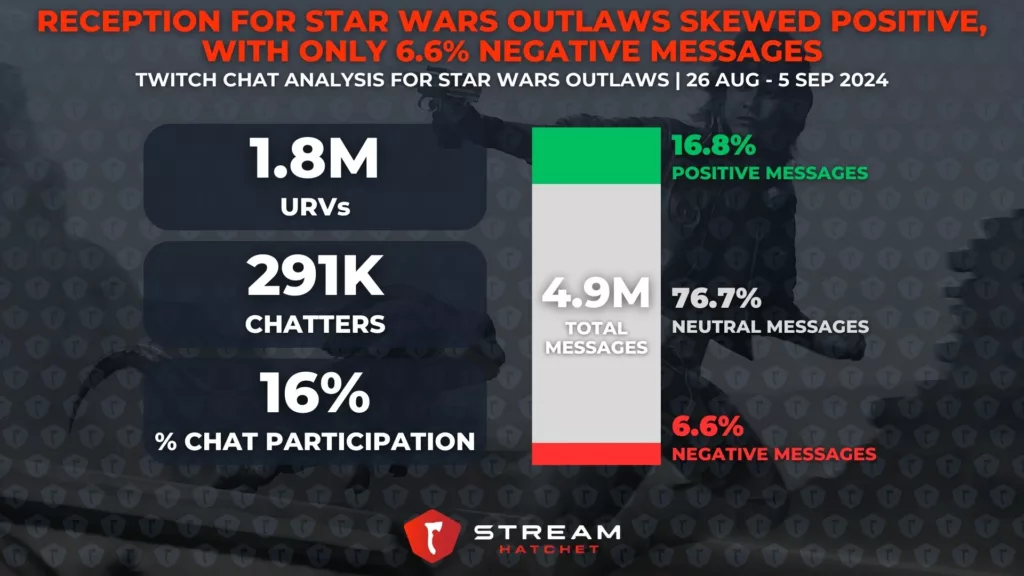
Sentiment: The overall tone of chat discussions, categorized as positive, neutral, or negative.
Purpose: Understanding sentiment helps brands gauge audience attitudes toward their product or marketing campaign, informing future strategies. Chat Mentions alone aren’t enough, when viewers could be making disparaging comments about a given game, publisher, or brand.
Example: The Sentiment for Star Wars Outlaws was, on the whole, mostly neutral. But positive messages did outweigh negative messages, which is impressive for a game using Star Wars IP – it most likely shows that hardcore fans were happy with the consistency of the world building with the greater Star Wars lore.
This selection of streaming stats is highly versatile. Taking almost any one of these stats, a brand or publisher could look at specific games, channels, developers, genres, release dates, devices, regions, and many, MANY more other aspects on live-streaming platforms. Stream Hatchet can even take this one step further, looking at trends over time for particular creators with our customized HATCHET score – a combined measure of a streamer’s popularity based partially on the stream stats discussed here.
To hear more about how to implement streamer stats in your own influencer marketing campaigns, or to find out about the HATCHET Score and our AI-powered creator discovery tools, speak with a Stream Hatchet analyst today:
